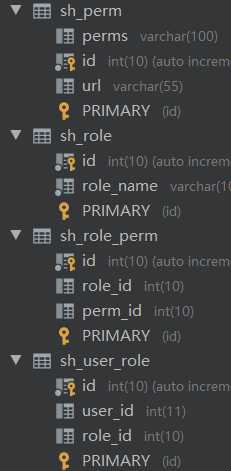shiro安全框架-用户认证授权以及权限控制
Posted mr-hanexp
tags:
篇首语:本文由小常识网(cha138.com)小编为大家整理,主要介绍了shiro安全框架-用户认证授权以及权限控制相关的知识,希望对你有一定的参考价值。
使用shiro之前肯定要导入相关的依赖
<!-- shiro-->
<dependency>
<groupId>org.apache.shiro</groupId>
<artifactId>shiro-spring</artifactId>
<version>1.5.3</version>
</dependency>
<dependency>
<groupId>org.apache.shiro</groupId>
<artifactId>shiro-core</artifactId>
<version>1.5.3</version>
</dependency>
<dependency>
<groupId>org.apache.shiro</groupId>
<artifactId>shiro-web</artifactId>
<version>1.5.3</version>
</dependency>
<!--thymeleaf-shiro整合-->
<dependency>
<groupId>com.github.theborakompanioni</groupId>
<artifactId>thymeleaf-extras-shiro</artifactId>
<version>2.0.0</version>
</dependency>
说明:最后一个是thymeleaf的整合包,前端如果需要使用标签就需要这个包。
使用shiro验证用户登录
数据库表

说明:密码是使用盐值加密进行处理后存放在数据库中的,salt是盐值。

spring-shiro.xml配置文件
<?xml version="1.0" encoding="UTF-8"?>
<beans xmlns:xsi="http://www.w3.org/2001/XMLSchema-instance"
xmlns="http://www.springframework.org/schema/beans"
xmlns:util="http://www.springframework.org/schema/util"
xsi:schemaLocation="http://www.springframework.org/schema/beans
http://www.springframework.org/schema/beans/spring-beans-4.0.xsd
http://www.springframework.org/schema/util
http://www.springframework.org/schema/util/spring-util.xsd">
<!--url过滤器-->
<bean id="urlPathMatchingFilter" class="www.han.filter.UrlPathMatchingFilter"/>
<!-- 登出出过滤器 -->
<bean id="logoutFilter" class="org.apache.shiro.web.filter.authc.LogoutFilter">
<property name="redirectUrl" value="/"/>
</bean>
<!--配置shiro的过滤器工厂类,id- shiroFilter要和我们在web.xml中配置的过滤器一致 -->
<bean id="shiroFilter" class="org.apache.shiro.spring.web.ShiroFilterFactoryBean">
<!-- 调用我们配置的权限管理器 -->
<property name="securityManager" ref="securityManager"/>
<!-- 配置我们的登录请求地址 -->
<property name="loginUrl" value="/router/toLogin"/>
<!-- 如果您请求的资源不再您的权限范围,则跳转到/403请求地址 -->
<property name="unauthorizedUrl" value="/router/nopower"/>
<!-- 过滤器 -->
<property name="filters">
<util:map>
<entry key="logout" value-ref="logoutFilter"/>
<entry key="url" value-ref="urlPathMatchingFilter"/>
</util:map>
</property>
<!-- 权限配置 -->
<property name="filterChainDefinitions">
<value>
<!-- anon表示此地址不需要任何权限即可访问 -->
/=anon
/static/**=anon
/router/*=anon
/*.html=anon
/login.do=anon
/register.do=anon
/logout=logout
<!--/staff/**=authc-->
<!-- 所有的请求(除去配置的静态资源请求或请求地址为anon的请求)都要通过登录验证,如果未登录则跳到/login -->
/**=url
</value>
</property>
</bean>
<!-- 会话ID生成器 -->
<bean id="sessionIdGenerator" class="org.apache.shiro.session.mgt.eis.JavaUuidSessionIdGenerator"/>
<!-- 会话Cookie模板 关闭浏览器立即失效 -->
<bean id="sessionIdCookie" class="org.apache.shiro.web.servlet.SimpleCookie">
<constructor-arg value="sid"/>
<property name="httpOnly" value="true"/>
<property name="maxAge" value="-1"/>
</bean>
<!-- 会话DAO -->
<bean id="sessionDAO"
class="org.apache.shiro.session.mgt.eis.EnterpriseCacheSessionDAO">
<property name="sessionIdGenerator" ref="sessionIdGenerator"/>
</bean>
<!-- 会话验证调度器,每30分钟执行一次验证 ,设定会话超时及保存 -->
<bean name="sessionValidationScheduler"
class="org.apache.shiro.session.mgt.ExecutorServiceSessionValidationScheduler">
<property name="interval" value="1800000"/>
<property name="sessionManager" ref="sessionManager"/>
</bean>
<!-- 会话管理器 -->
<bean id="sessionManager"
class="org.apache.shiro.web.session.mgt.DefaultWebSessionManager">
<!-- 全局会话超时时间(单位毫秒),默认30分钟 -->
<property name="globalSessionTimeout" value="1800000"/>
<property name="deleteInvalidSessions" value="true"/>
<property name="sessionValidationSchedulerEnabled" value="true"/>
<property name="sessionValidationScheduler" ref="sessionValidationScheduler"/>
<property name="sessionDAO" ref="sessionDAO"/>
<property name="sessionIdCookieEnabled" value="true"/>
<property name="sessionIdCookie" ref="sessionIdCookie"/>
</bean>
<!-- 安全管理器 -->
<bean id="securityManager" class="org.apache.shiro.web.mgt.DefaultWebSecurityManager">
<property name="realm" ref="databaseRealm"/>
<property name="sessionManager" ref="sessionManager"/>
</bean>
<!-- 相当于调用SecurityUtils.setSecurityManager(securityManager) -->
<bean class="org.springframework.beans.factory.config.MethodInvokingFactoryBean">
<property name="staticMethod"
value="org.apache.shiro.SecurityUtils.setSecurityManager"/>
<property name="arguments" ref="securityManager"/>
</bean>
<!-- 密码匹配器,自动校验密码 -->
<bean id="credentialsMatcher" class="org.apache.shiro.authc.credential.HashedCredentialsMatcher">
<property name="hashAlgorithmName" value="md5"/>
<property name="hashIterations" value="1"/>
<property name="storedCredentialsHexEncoded" value="true"/>
</bean>
<!--注入DatabaseRealm类-->
<bean id="databaseRealm" class="www.han.config.shiro.UserRealm">
<property name="credentialsMatcher" ref="credentialsMatcher"/>
</bean>
<!-- 保证实现了Shiro内部lifecycle函数的bean执行 -->
<bean id="lifecycleBeanPostProcessor" class="org.apache.shiro.spring.LifecycleBeanPostProcessor"/>
</beans>
注意/**=url要放在最后面,如果放在前面就先执行的url过滤,静态资源和开放权限的跳转会失效。
shiroUtil(对密码进行加密)
import org.apache.shiro.crypto.SecureRandomNumberGenerator;
import org.apache.shiro.crypto.hash.SimpleHash;
public class ShiroUtil {
public static String encryptPassword(String password, String salt) {
// 在这里更改密码规则后还要在applicationContext-shiro.xml中改密码匹配器
return new SimpleHash("md5", password, salt, 1).toString();
}
public static String generateSalt() {
return new SecureRandomNumberGenerator().nextBytes().toString();
}
}
写核心的授权验证realm
package www.han.config.shiro;
import at.pollux.thymeleaf.shiro.dialect.ShiroDialect;
import org.apache.shiro.authc.AuthenticationException;
import org.apache.shiro.authc.AuthenticationInfo;
import org.apache.shiro.authc.AuthenticationToken;
import org.apache.shiro.authc.SimpleAuthenticationInfo;
import org.apache.shiro.authz.AuthorizationInfo;
import org.apache.shiro.authz.SimpleAuthorizationInfo;
import org.apache.shiro.realm.AuthorizingRealm;
import org.apache.shiro.subject.PrincipalCollection;
import org.apache.shiro.util.ByteSource;
import org.springframework.beans.factory.annotation.Autowired;
import org.springframework.context.annotation.Bean;
import www.han.pojo.User;
import www.han.service.PermService;
import www.han.service.RoleService;
import www.han.service.UserService;
import java.util.Set;
//自定义Realm
public class UserRealm extends AuthorizingRealm {
@Autowired
private UserService userService;
@Autowired
private PermService permService;
@Autowired
private RoleService roleService;
//授权
@Override
protected AuthorizationInfo doGetAuthorizationInfo(PrincipalCollection principalCollection) {
//账号已经通过验证了
String userName =(String) principalCollection.getPrimaryPrincipal();
System.out.println("授权中得到的userName:"+userName);
//通过service获取角色和权限
Set<String> permissions = permService.getPerms(userName);
Set<String> roles = roleService.getRoles(userName);
//授权对象
SimpleAuthorizationInfo s = new SimpleAuthorizationInfo();
//把通过service获取到的角色和权限放进去
s.setStringPermissions(permissions);
s.setRoles(roles);
return s;
}
//认证
@Override
protected AuthenticationInfo doGetAuthenticationInfo(AuthenticationToken token) throws AuthenticationException {
System.out.println("执行了认证+===》doGetAuthenticationInfo");
// 获取名字
String name = token.getPrincipal().toString();
System.out.println(name);
// 获取user
User admin = userService.loginByName(name);
if (admin == null){
return null;
}
String passwordInDB = admin.getUser_password();
String salt = admin.getSalt();
return new SimpleAuthenticationInfo(name, passwordInDB, ByteSource.Util.bytes(salt), getName());
// getName()是realm的继承方法,返回当前类名DatabaseRealm
// 通过applicationContext-shiro.xml中的HashedCredentialsMatcher,进行密码的自动校验
}
}
登录以及注册控制
@RequestMapping(value="/login.do",method = RequestMethod.POST)
public String loginControl(String username, String password, Model model){
//获取当前用户,shiro包下的
Subject subject = SecurityUtils.getSubject();
//封装用户的登录数据
UsernamePasswordToken token = new UsernamePasswordToken(username, password);
//执行登录方法
try {
subject.login(token);//执行登录,在用户认证的里面去认证用户名和密码
Session session=subject.getSession();
session.setAttribute("subject", subject);
return "redirect:/router/toIndex";//登录通过转到首页
}catch (UnknownAccountException e){//用户名不存在
model.addAttribute("msg","用户名不存在");
return "login";
}catch (IncorrectCredentialsException e){//密码不存在
model.addAttribute("msg","密码错误啊");
return "login";
}
}
@RequestMapping(value = "/register.do",method = RequestMethod.POST)
public String register(String user_id,String user_name,String user_password,String user_phone,Model model){
User user = new User();
user.setUser_id(Integer.parseInt(user_id));
user.setUser_name(user_name);
user.setUser_password(user_password);
user.setUser_phone(user_phone);
String salt = new Random().nextInt(1000000)+"";//通过随机数来设置盐值
user.setSalt(salt);
String encryptPassword = ShiroUtil.encryptPassword(user.getUser_password(), user.getSalt());//将密码和盐值混合加密
user.setUser_password(encryptPassword);
int register = userService.register(user);
if (register > 0){
//进行角色分配,注册的角色都设置为普通用户
int i = roleService.addRole(user.getUser_id());
if (i <= 0){
model.addAttribute("msg","账号注册成功!角色分配失败,请联系管理要换进行权限分配!");
System.out.println("角色分配失败!请手动进行分配!");
}
model.addAttribute("msg","注册成功!");
return "login";
}else{
return "login";
}
}
说明:数据库中对应的有一个权限表,用户表,角色表,用户对应的角色表,角色对应的权限表,通过这几个表就能轻松实现不同用户的角色分配以及权限分配。
url过滤器(因为采用的是权限控制用url)
package www.han.filter;
import org.apache.shiro.SecurityUtils;
import org.apache.shiro.authz.UnauthorizedException;
import org.apache.shiro.subject.Subject;
import org.apache.shiro.web.filter.PathMatchingFilter;
import org.apache.shiro.web.util.WebUtils;
import org.springframework.beans.factory.annotation.Autowired;
import www.han.service.PermService;
import javax.servlet.ServletRequest;
import javax.servlet.ServletResponse;
import java.util.Set;
public class UrlPathMatchingFilter extends PathMatchingFilter {
@Autowired
PermService permService;
@Override
protected boolean onPreHandle(ServletRequest request, ServletResponse response, Object mappedValue) throws Exception {
System.out.println("进来了PathMatchingFilter");
String requestUrl = getPathWithinApplication(request);
System.out.println("PathMatchingFilter---"+requestUrl);
Subject subject = SecurityUtils.getSubject();
if(!subject.isAuthenticated()){
// 未登录
WebUtils.issueRedirect(request,response,"/router/toLogin");
return false;
}
System.out.println("permService-----"+permService);
boolean needInterceptor = permService.needInterceptor(requestUrl);
// System.out.println("是否需要权限验证:"+needInterceptor);
if(!needInterceptor){//如果数据库中没有该权限的信息,就直接放行
return true;
}else{
boolean hasPermission = false;
String userName = subject.getPrincipal().toString();
Set<String> permissionUrls = permService.getUrl(userName);
for(String url:permissionUrls){
if(requestUrl.equals(url)){
hasPermission = true;
}
}
if(hasPermission){
return true;
}else{
UnauthorizedException e = new UnauthorizedException("当前用户没有访问"+requestUrl+"的权限");
subject.getSession().setAttribute("e",e)
WebUtils.issueRedirect(request,response,"/router/nopower");
return false;
}
}
}
}
权限控制
- 在数据库中存放需要有权限操作的请求路径,然后前端可以用标签来验证用户是否拥有某个权限从而达到不同的数据显示给不同级别的用户。
以上是关于shiro安全框架-用户认证授权以及权限控制的主要内容,如果未能解决你的问题,请参考以下文章